
The Circular Chess Society Information Pack
The is an informational page on the Circular Chess Society, and Circular Chess in general.
Positions and Movement
Pieces line up facing outwards around the board. Relative positions Q/K to Rook is as on the square board. Queens sit on their own colour.
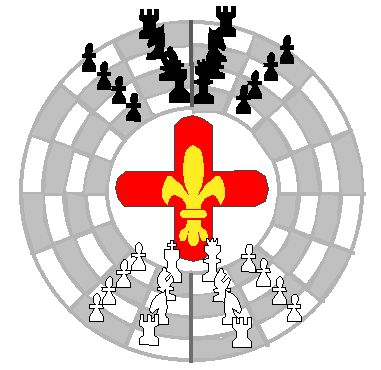
With the exception of pawns, all pieces can go in either direction from the start. The promotion line is between the kings and queens. The central area is out of bounds and can be used for the storage of pieces which have been taken.
Null moves are not permitted. ie a rook cannot be moved all the way round the board back to where it started.
Queen
Immensely powerful. It moves diagonally or straight as far as the board edges, or round the board on the same ring.
Rooks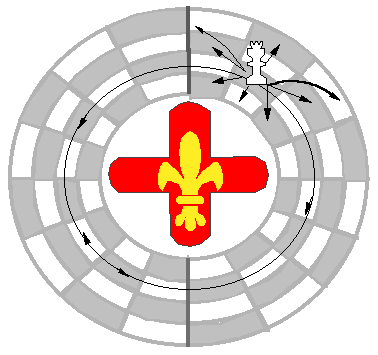
Round and round or from one ring to another.
Pawns
These advance one square at a time around the board until they reach the promotion line whereupon they can be promoted to whichever piece is desired. They do not have to cross the line (equivalent of reaching the other side on the square board). Pawns take diagonally and whilst they can leap two cells in the first move there is no en passent.
Knights 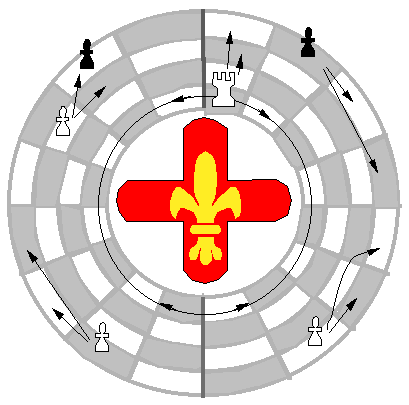
Two forward one across or vice versa applies. The mobility and power is less than normal but used properly the knight can be a very useful and deceptive weapon especially given that it moves different distances depending on its position.
Bishops
Similarly the bishops range is curtailed and to get round the board can take some manoeuvring. However, diagonals are not straight and the reverse movement is easily overlooked.
The King
As ever.
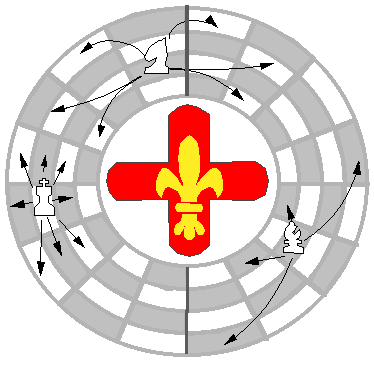
The Society
-a Potted HistoryIn 1983 Lincoln painter and decorator, and niche historian, David Reynolds, came across a picture of a circular chess board in use in the 11th century. He was intrigued by this and constructed a cardboard cut-out. The book had no description of how to play and so he decided that normal rules would apply. He then took the board to his local pub and challenged unfortunate bystanders.
Dave was an enthusiastic, if rudimentary chess player. Such deviousness as castling and en passent met with a furrowed brow and a shake of the head. It was his board and so opponents had to concede to his wisdom. Ideas like bouncing bishops, ricocheting off the sides, were instantly dismissed.
Interest grew in this strange phenomenon and in 1993 Dave decided to hold a competition. The success of this urged him on to greater things and he teamed up with production manager Eamonn Hunt to produce boards for general release at the Lincoln Christmas market. A result of this venture was, in his words, adequate stocks in the attic. The competition had introduced circular chess to pub regular Rob Stevens. Over the next few years it became a regular sight in the Lincoln Tap and Spile as he and Dave locked horns over a pint or few.
Word got round and the 1996 competition was opened beyond the Tap. It was featured in The Daily Telegraph and on Radio 4. The final was shown on C4s Transworld Sport. It is still early days but we now have international membership and increasing recognition within normal and variant chess.
World Championships
Rob won the first World Championships in 1996. The following year (sponsored by F & J Cycles) Francis Bowers, a former normal board county champion and captain from Spalding UK won in a play off. His winning phrase delighted appeared on televisions around the globe. The Beaver Design 1998 championships saw increased international flavour with the introduction of Herman Kok (Netherlands). Also present was an Irish representative who flew in from Turkey, and Jones the Post (Wales). Francis retained his title, winning a tense final match against Herman. The 1999 championship sponsored by Lindum Group attracted more players from the world of serious chess. Francis once more confounded the critics to retain the title in a spectacular play off against Paul Byway, Hertfordshires normal board county star and recognised master at the craft.
The millennium saw Herman Kok (Netherlands) sweep all challengers before him to take the title with a bishop attack that has become his hallmark. He could not sustain this in 2001 however and an early round draw saw him lose the championship by half a point to that man Bowers who won every game. Herman looks for revenge in the 2002 Championships (19 May) but he is not alone.
Membership
Membership is £5 (free with a board). It includes irregular updates in the form of Chessnuts, the Society newsletter, and much more.
Want a Board?
The board currently available from the Society is two foot wide and approx. 2/3 inch thick. It is handmade from best quality veneered medium density fibre wood (MDF) and is hand painted. The cost of a board is £35 + £5 UK p&p. (cheques made to the Circular Chess Society).
Membership Form
The Setup
Start with a square board. It has two halves, the queen side and the king side. Each has four files. These are joined along the middle. Separate the two halves and force them together with rooks back to back. The result is an ellipse. Widening the inner cells gives the circular board.
Filling in the hole gives a convenient place to keep prisoners.
Shrouded in mystery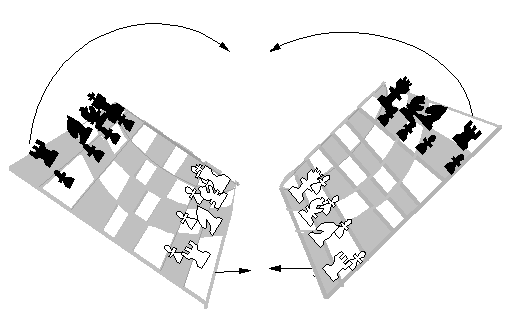
The circular board is known to have been used in the Byzantine period (in the 1100s). Its roots are unclear but it is said to have been known to great theoreticians and tactical geniuses of the day (including, rumour has it, Lincoln monks). It was played using the same moves as square chess at the time. Bishops were elephants moving two squares diagonally. Pawns moved one square forward and didnt have a optional jump start of two squares. The queen (general) could move just one diagonal square at a time. To make things worse, on the circular board pawns didnt promote but just kept on going round and round. Yawn.
Chess was popularised by variant square players of the 1400s who came up with new rules which are essentially those we see today. Circular chessers were perhaps left behind, for their game to die out apart from a few devotees. Until recently that is, when by a quirk of fate, Lincoln historian David Reynolds rediscovered the board and applied those new rules to it.
Principles
The number of pieces, number of squares, the moves, and the tricks and traps are the same as normal. By virtue of the shape of the board the rooks and queen can control over three quarters of playing area and leap roundabout six feet at a time. Pieces sitting harmlessly in one quadrant of the board may therefore in fact be lurking ready to strike on the other. The Knights hop different distances depending on the direction, making them particularly deceptive. Diagonals are not straight and, as we all find out, beware the reverse bishop.
Discovered attacks, pins, skewers and forks are most effective and players must always watch their backs. Spectators must maintain silence if they see an obvious move, it is likely that neither player has noticed.
Tactics
Some opt for a massive attack on one side which can overwhelm the opposition but can leave them exposed to counter attack on the other. A simultaneous attack on both sides can leave inadequate defence if the opponent opts for a single side onslaught, but may prove advantageous if that attack can be thwarted. Early developers have an advantage but must be wary of over stretching as they may find retreat difficult. There are no books of opening theory nor computer programs to work out the best tactics. The only way to find out what suits you is to play.
WWW page created: 25 April 2001. Last updated: 27 Feb 2002.